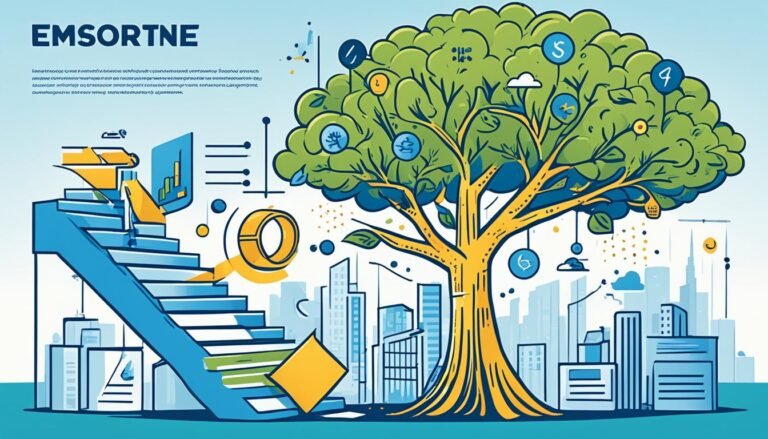The Evolution of Green Bonds in Sustainable Finance
In 2020, green bond issuance hit a peak of $350 billion worldwide.
Green bonds are changing the game in finance for the better. They help fund projects that positively impact the environment and encourage sustainable growth. This is why they are important.
Key Takeaways:
- Green bonds are debt securities that exclusively finance environmentally sustainable projects.
- They have gained popularity due to the growing demand for socially responsible investments and the need to address climate change.
- The World Bank played a crucial role in the birth of green bonds, issuing the first green bond in 2008.
- Green bonds offer benefits to investors, including the opportunity to align investments with their values and contribute to the development of a green economy.
- The global green bond market has experienced exponential growth, with more than 50 countries issuing green bonds.
What Are Green Bonds?
Green bonds are special debt securities designed to fund eco-friendly projects. They are also called climate bonds. They fund projects that help the environment and climate. Unlike regular bonds, the money from green bonds only goes to sustainable projects.
These projects include a variety of initiatives, such as:
- Energy efficiency projects
- Renewable energy projects
- Pollution prevention and control measures
- Sustainable land management
- And more
Green bonds are becoming more popular because people want to invest responsibly. They also want to fight climate change. By buying green bonds, people and companies can help create a more eco-friendly future.
“Green bond issuance reached a record $269.5 billion in 2020, reflecting growing investor demand for sustainable and responsible investing.” – Bloomberg
The Impact of Green Bonds
Green bonds can lead to big positive changes for our planet. They fund projects that are good for the environment. This helps fight climate change and supports green growth.
Investing in green bonds has many benefits:
- Alignment with Sustainable Finance Goals: They match investment goals with sustainable projects.
- Diversification and Risk Mitigation: They include different sustainable assets which can reduce risk.
- Financial Returns: They can be profitable and good for the Earth at the same time.
Green bonds help investors, companies, and policymakers work together. They promote green finance and environmental improvement.
The Birth of Green Bonds
The World Bank was crucial in creating green bonds. In 2008, it responded to a need from Swedish pension funds. These funds wanted to invest in climate projects. So, the World Bank issued the world’s first green bond.
This event was a big change in financing climate projects. The idea of a bond for a specific project was new. Yet, it changed the game. The World Bank’s experience in environmental projects helped. With support from investors, development experts, and policymakers, green bonds grew in sustainable finance.
“The World Bank’s issuance of the first green bond in 2008 was a watershed moment in sustainable finance. It demonstrated how bonds can be used as a powerful tool to finance projects that address climate change and support environmental sustainability. This innovative approach attracted the attention of investors, development experts, and policymakers, sparking a global movement towards green finance.”
Since the World Bank took the first step, green bonds became popular. Many organizations started using them for eco-friendly projects. Investors and policymakers noticed. They saw green bonds as a way to fund sustainable initiatives and fight climate change.
Green Bonds and Climate Projects
Green bonds fund projects good for the environment. This includes renewable energy and energy-efficient infrastructure. They also support sustainable land management and pollution control. By selling green bonds, organizations get money for these important projects. This helps speed up their plans and fight climate change.
The start of green bonds was a big moment in finance. It led to a world focused more on environmental sustainability. This was thanks to the World Bank’s first green bond. It set a path for financing that matches the goals of many, for a greener future.
| Key Players | Contributions |
|---|---|
| World Bank | Issued the first green bond in 2008 |
| Investors | Supported green bond initiatives |
| Development experts | Provided insights and guidance |
| Policymakers | Created regulations and incentives |
Benefits and Challenges of Green Bonds
Green bonds are catching lots of attention in sustainable finance world. They benefit both investors and our planet. By backing eco-friendly projects, investors match their values with their investments. This helps push us towards a greener future. Green bonds also offer good financial returns, similar to regular bonds. This makes them attractive to anyone looking for profit and impact.
Green bonds play a big part in creating a green economy. They support projects aimed at solving environmental problems. This includes things like renewable energy, energy-efficient buildings, and eco-friendly transport. Thus, green bonds help us move towards a less polluting, more resource-efficient economy. They’re paving the way for a better environment for the next generations.
Still, green bonds face some hurdles. Making sure there are clear, standard rules for choosing and certifying projects is a big one. Without these standards, there’s confusion and risks of greenwashing. This is when projects claim to be eco-friendly but aren’t. To solve this, adopting global standards, like the Climate Bonds Standard, is crucial.
Transparency and the way green bonds are reported and watched is key. Investors need correct, up-to-date info about the eco impact of their financed projects. With strong reporting and monitoring, green bond issuers can give investors the data they need. This proves their investments are truly making a difference for our planet.
Green bonds stand out because they offer environmental benefits and financial returns. They’re appealing to anyone interested in sustainable finance. Yet, being clear, setting standards, and reporting well are important. They help solve green bonds’ challenges and maximize their role in creating a positive change.
| Benefits of Green Bonds | Challenges of Green Bonds |
|---|---|
| Support projects that align with environmental sustainability | Need for clear and standardized project selection and certification criteria |
| Generate financial returns comparable to conventional bonds | Lack of consistent standards and potential for greenwashing |
| Contribute to the development of a green economy | Transparency, reporting, and monitoring |
| Achieve sustainable development goals |
The Growth and Impact of Green Bonds
Since 2008, green bonds have grown significantly. They are crucial in sustainable finance. These bonds fund projects good for the environment and sustainable development. Over 50 countries have issued green bonds. The US is the biggest issuer.
The Climate Bonds Initiative reported a $350 billion issuance in 2020. This shows a high interest in sustainable finance. Green bonds are essential for fighting climate change and supporting sustainable development.
Green bonds fund important eco-friendly projects. They help in renewable energy, sustainable transportation, and climate adaptation. This supports a greener, low-carbon future.
“Investing in green bonds allows individuals and institutions to align their financial portfolios with their values, supporting projects that address climate change and promote sustainability.”
The green bond market’s growth signals a shift in how investors think. Investors now consider environmental considerations in their decisions. As concerns over climate risks grow, so does interest in green bonds. This attracts various investors.
To understand green bonds’ impact, here’s a table comparing issuances by country:
| Country | Green Bond Issuances (2020) |
|---|---|
| United States | $148.4 billion |
| China | $78.2 billion |
| France | $45.7 billion |
| Germany | $36.2 billion |
| Netherlands | $27.8 billion |
This table shows the US leading in green bond issuances, with China, France, Germany, and the Netherlands following. Their commitment to sustainable finance and green projects boosts green bonds globally.
The rise of green bonds shows growing efforts to combat climate change and enhance sustainable development. Green bonds blend financial gains with environmental good. They offer an investment that matches personal ethics with the goal of a sustainable world.
Investor and Policy Perspectives
Investors and policymakers are key to sustainable finance in the green bond market. Green bonds give investors chances to diversify and reduce risks. They also let investors build strong portfolios with environmental, social, and governance (ESG) elements. Including ESG in investments helps the planet and is part of responsible investing.
Learning from successful green bond investments is important for investors. These examples show the impact and financial benefits of green bonds. They help investors see how green bonds help sustainable development and the environment.
Example Case Study: XYZ Renewable Energy Corporation
“Investing in green bonds from XYZ Renewable Energy Corporation was a smart move. We got good returns and helped clean energy development. This matches our goals for sustainable finance and responsible investing. We’re happy to back projects that positively affect the environment.” – John Smith, Chief Investment Officer at ABC Investments
Policymakers greatly influence the green bond market. They use rules and benefits to support sustainable finance. Governments give tax breaks and credits to draw more investors to green bonds. These incentives help finance projects that are good for the planet.
Policymakers work with investors and issuers to make a good environment for green bonds. They push for practices that make finance more sustainable. This helps change the finance world in a positive way.
| Investor Perspectives | Policy Perspectives |
|---|---|
| Opportunity for diversification and risk mitigation | Regulations and incentives for green bond issuance |
| Integration of ESG factors into portfolio design | Tax exemptions and credits to attract investors |
| Case studies provide insights into impact and financial performance | Driving the adoption of sustainable finance practices |
Investors and policymakers working together in the green bond market is crucial. They can make a sustainable and strong global economy by focusing on green bonds. By aligning their strategies with sustainable finance, they bring positive change and a greener future.
Verifying Green Bonds
To ensure investors aren’t misled, green bonds are checked by third-party groups. The Climate Bonds Initiative is one such group. It lists third-party verifiers for green bonds. These groups check if green bond projects are credible and good for the planet. They make sure these projects follow strict standards and truly benefit the environment. This process is key for keeping the green bond market honest and gaining investors’ trust.
Climate Bonds Initiative: Third-Party Verifiers Directory
| Verifiers | Website |
|---|---|
| XYZ Verifier | https://www.xyzverifier.com |
| Green Assurance | https://www.greenassurance.org |
| EcoVerify | https://www.ecoverify.org |
Third-party verification makes green bonds more trustworthy. It reassures investors about the environmental goals of these bonds. This avoids greenwashing, where projects claim to be “green” but don’t help the planet as promised. The Climate Bonds Initiative and similar groups are key. They ensure the green bond market is transparent and trustworthy. This boosts confidence among investors.
Tax Incentives and Advantages
Green bonds come with perks beyond helping the environment. They have tax perks that attract investors looking to do good. Tax exemptions or credits are offered, depending on who is issuing them and where.
These tax perks aim to motivate investors to fund green projects. They lessen the financial load on investors. This makes green bonds more tempting investment choices.
In some places, you get tax breaks on the interest from green bonds. This lets investors keep more of their earnings. In other cases, tax credits reduce what you owe in taxes. This lightens your tax load.
Such incentives lure investors and steer more money towards eco-friendly projects. Green bonds match financial benefits with environmental goals. They’re key in funding the move to a greener economy.
The incentives acknowledge the value of green investments. They back sustainable development goals too.
| Tax Incentives | Description |
|---|---|
| Tax Exemptions | Exemptions on interest earned from green bonds |
| Tax Credits | Credits that can be offset against tax liabilities |
Attracting Investors and Promoting Sustainable Finance
“Tax incentives enhance the attractiveness of green bonds as investment options, encouraging investors to finance projects with positive environmental impact.”
Tax benefits boost interest in green bonds among investors. With these financial advantages, green bonds outshine regular investments. They funnel more funds into eco-friendly projects and back sustainability aims.
Green bonds are attractive because they offer both profit and positive impact on the environment. They are appealing to investors who care about the earth. Tax incentives make them even more compelling for those supporting green finance. This helps push our economy towards greener practices.
Conclusion
The growth of green bonds has been a key player in pushing for a more sustainable future. These bonds let investors put their money into what matters to them while earning returns. This has made the green bond market expand big time, showing that people are getting more into sustainable finance.
Green bonds are set to play a bigger role in finance, aiming to tackle climate change and boost the green economy. It’s crucial for the finance world to adopt eco-friendly investment strategies. This will unlock the true value of green bonds and lead to a sustainable, tough global economy.
As our planet leans more towards green living and a low-carbon economy, green bonds stand out as a solid choice. They finance projects in renewable energy and sustainable transport, among others. This way, investors can have a real impact while meeting their financial targets. The green bond market’s growth showcases the vital role of eco-investments and finance’s impact on positive changes.
Finally, green bonds have become a potent instrument in sustainable finance, channeling funds to eco-friendly projects. By putting money in green bonds, everyone from individuals to governments can help foster a green economy. This brings benefits that last, for both our environment and our wallets.
Source Links
- https://www.routledge.com/Green-Bonds-and-Sustainable-Finance-The-Evolution-of-Portfolio-Management/Meo-Staniewski/p/book/9781032686837
- https://www.worldbank.org/en/news/feature/2018/11/27/from-evolution-to-revolution-10-years-of-green-bonds
- https://corporatefinanceinstitute.com/resources/esg/green-bond/








